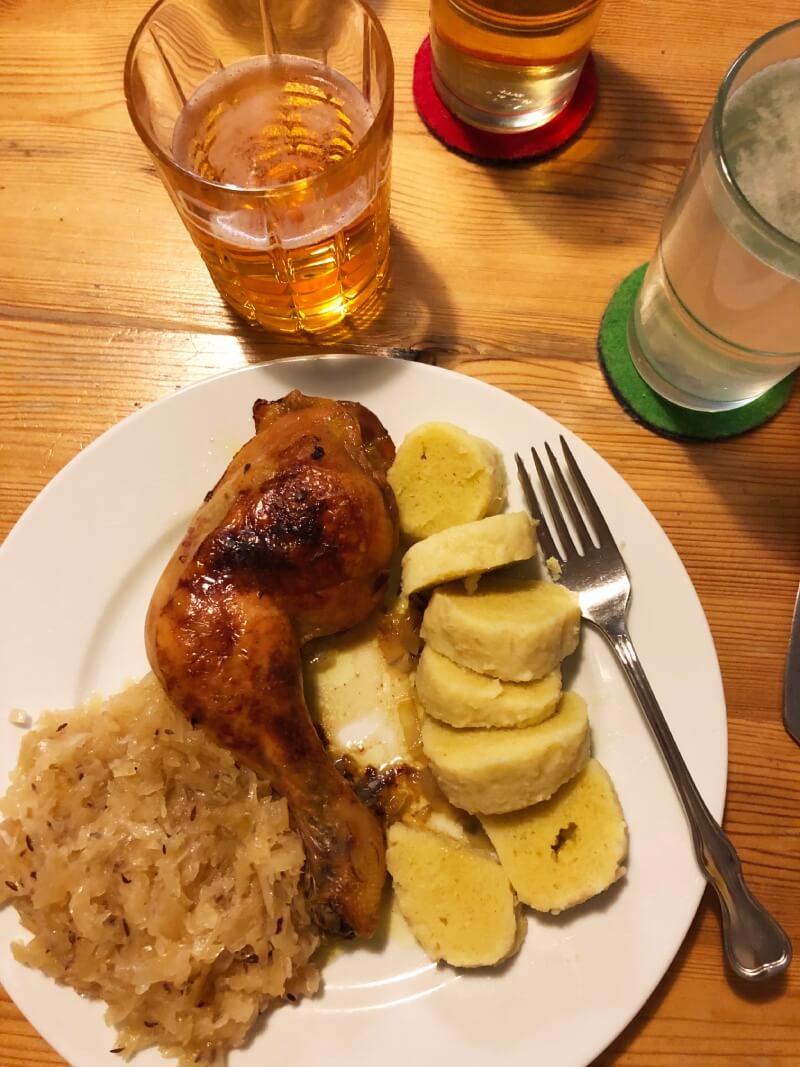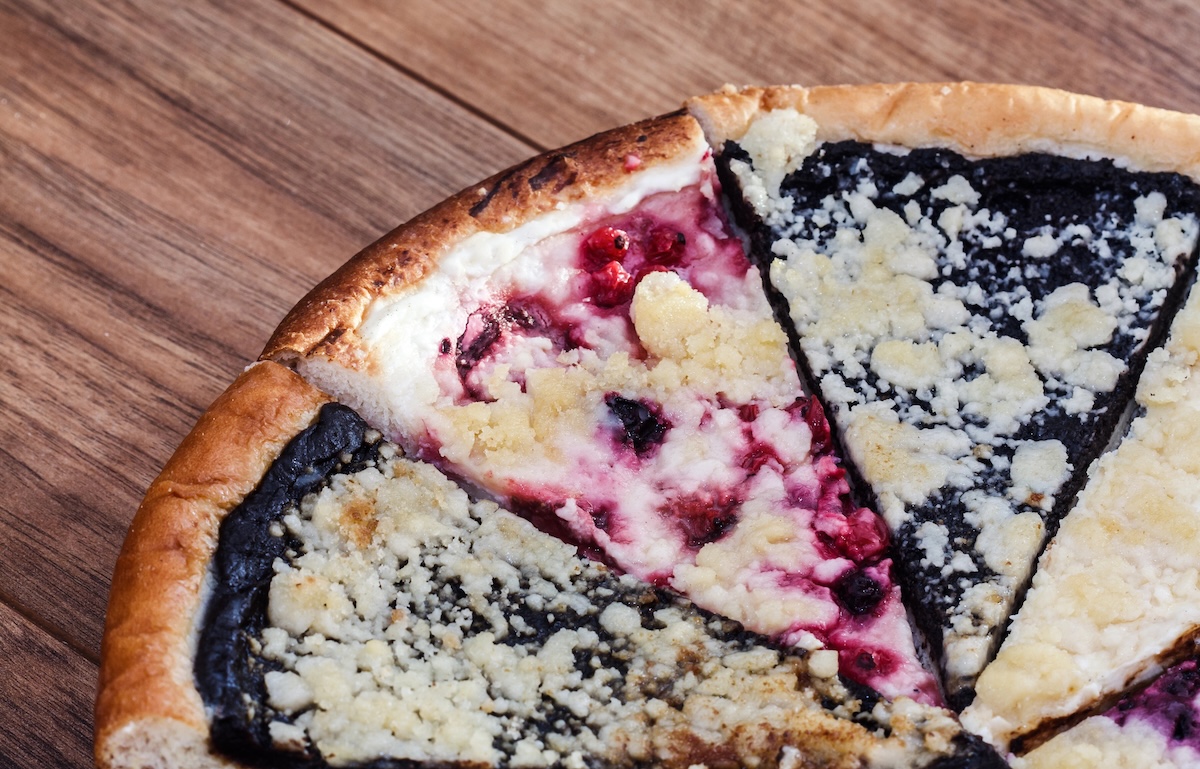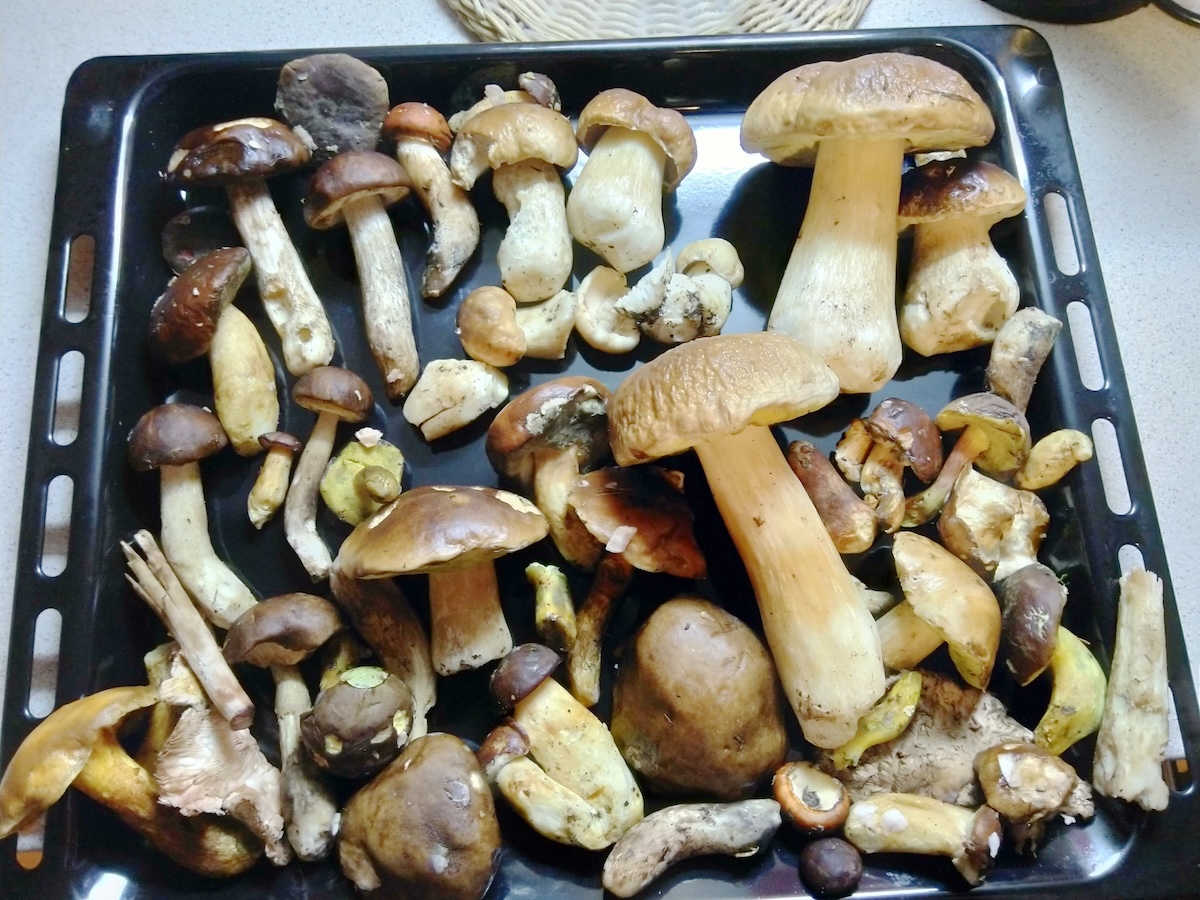- Home
- Czech life
- Czech food
Czech Food Guide: Traditional Dishes You Must Try in Prague
Planning a trip to Prague? Or maybe you're hungry for a taste of Czech food and culture? You’re in the right place.
 Roasted chicken, cabbage and potato dumplings
Roasted chicken, cabbage and potato dumplingsFrom dumplings to desserts, my guide dishes out the best of Czech food. And when you're done reading, don’t miss our quick quiz to see how much you really know!
Table of Contents
- What Do Czechs Eat in a Day?
- Classic Czech Dishes
- Sides, Staples, and What’s Missing?
- Sweet Treats
- What Do Czechs Drink?
- Changing Food Scene in Prague
- Frequently Asked Questions
- Take the Quiz!
Czech food is warm, hearty, and built to satisfy. It's not diet food. Don't expect a lot of raw vegetables or fresh salads.
If you're visiting Prague, expect comforting dishes on the heavy side. The kind that will fill you up at lunch and have you considering a light dinner.
The cuisine reflects centuries of Central European tradition, with a focus on meats, dumplings, and rich sauces.
While you’ll find modern and international restaurants throughout Prague, most locals still enjoy classic Czech meals at home or in pubs.
So, getting to know more about Czech food will give you an understanding of the country’s culture and hospitality.
🍽️ What Do Czechs Eat in a Day?
This is a general overview of traditional meals and routines. Not everyone is the same, but this will give you an idea of the typical Czech meal pattern.
Meals follow a predictable rhythm:
- Breakfast is light and there's not much cooking going on. People often eat fresh rolls or rye bread with butter, cheese, or cold cuts, accompanied by tea or coffee. Yoghurt, muesli, and oatmeal may be options - but certainly less traditional.
- Lunch is the main meal of th day. It often features soup followed by a hot, hearty dish. In fact, many restaurants offer a "menu" (prix fixe) lunch with both courses at an affordable price. Even schools will serve soup with every lunch.
- Dinner is typically simpler and may include open-faced sandwiches, leftovers from lunch, or a smaller warm dish.
What about snacking?
Expect lots of baked goods, like a plain roll (rohlík) or a classic Czech cake (koláč) with an afternoon coffee.
If you're on the go, stopping at a bakery or small grocery for something quick is very common.
 Czech cake with fruit toppings
Czech cake with fruit toppings🥘 Classic Czech Dishes You Should Try
Czech cuisine is all about comfort and flavor. If you're visiting Prague, put these on your list of meals to try. You'll find them in many restaurants and a commonly noted on placards, especially in Old Town.
First off, we have the Czech national dish, Vepřo-knedlo-zelo. That's a shortened term for roast pork with dumplings and stewed cabbage.
Another traditional dish is svíčková na smetaně, or commonly called svíčková. This is marinated beef sirloin with a slightly sweet creamy vegetable sauce, served with dumplings for soaking up the sauce. It also includes a decorative spoonful of cranberry sauce and whipped cream as well. It's rich and deeply satisfying.
Next up, guláš. A Czech twist on goulash with stewed beef in a paprika sauce. It's more mild than the Hungarian version with less vegetables. Serviced with bread dumplings or dark bread.
Czechs love their řízek, or schnitzel. This is a classic breaded and fried pork or chicken cutlet is often served with mashed, boiled potatoes or sometimes french fries. And, don't be surprised if you see someone on a train eating one as the sole ingredient between two slices of bread.
Finally, let's talk bramboráky. These crispy (and often greasy) potato pancakes are made with garlic and marjoram. It's an old-fashioned, filling, cheap-eat. Best eaten fresh and hot!
Did you know...?
Czech Republic has a long tradition of foraging wild edible mushrooms. It's something of a leisure activity and passion for many people. The mushrooms are dried and often used in soups, i.e. potato soup.
 We picked these wild Czech mushrooms
We picked these wild Czech mushrooms🍞 Czech Food: Sides, Staples, and What’s Missing
We can't discuss Czech food without highlighting the role of the popular side dish, knedlíky (dumplings). Dumplings are served with a number of dishes and they're filling and built for soaking up sauces.
It's important to note that there are two types of dumplings: bread-based and potato-based.
Bread dumplings (houskové knedlíky) are made from white bread. They're steamed in loaves and sliced into soft, fluffy rounds. They have a lighter texture and are more absorbent for sauces and gravies. You will likely get these automatically with dishes like svíčková or guláš.
On the other hand, potato dumplings (bramborové knedlíky) are made from grated or mashed potatoes. See the picture above.
They're denser and more filling, and have a slightly chewy texture. Potato dumplings are frequently paired with roasted meats or even filled with smoked meat. While both types of dumplings are staples of Czech cuisine, they offer very different textures and eating experiences.
Sauerkraut, or stewed cabbage (dušené zelí), is also paired with a number of Czech dishes. It's usually tangy and warming, which makes a good complement to roasted meats. And, you'll find this made with either red or white cabbage.
What about fresh veggies?
Czech cuisine is low on raw greens and other vegetables. In classic dishes, potatoes are the go-to vegetable for a side dish. These are most commonly boiled and served as a side.
Fresh vegetables are either missing completely or may come as a complementary side - like a garnish. While modern restaurants are catching on (especially in Prague), you won’t find many salads in traditional fare.
What do Czechs say before eating? Bon appétit? Guten Appetit?
Czechs say Dobrou chut' before meals. The literal translation is something like 'Good taste'.
🍰 Sweet Treats to End Your Meal
Czech desserts are comforting, homey, and often tied to holidays or family recipes. It seems everyone has a story about visiting their grandmother and the scent of her classic baking. Or, there are stories of families who bake the most cookies at Christmas... and so on.
Here are a few Czech specialties that are worth trying while in Prague. Interestingly, desserts are not overly sweet and rich. They are more commonly a hearty dough or flour-based companion.
- Koláče - sweet pastries filled with poppy seeds, plum jam, sweet cheese, or apricots.
- Buchty - soft yeast buns stuffed with jam or quark (crumbling sweet cheese). Often eaten as snacks or desserts.
- Palačinky - thin pancakes (like crepes) that are filled with jam, fruit, Nutella or other sweet fillings and even whipped cream.
Pro tip: Try palačinky at a local café, or better yet, during the weekend farmers' markets. You'll find them with both sweet and savory fillings
🍻 What Do Czechs Drink?
I could probably create a separate website just for Czech food and drinks. To keep things moving along, here are a few typical Czech beverages that you should try - especially if you're visiting Prague.
- Beer (pivo) - yes, it's a no-brainer and the pride of the Czech Republic. Czechs drink more beer per capita than any other country. The most popular is Pilsner Urquell, which is a golden lager but there are hundreds of breweries across the country. Beers commonly found in Prague include Kozel, Staropramen, Budvar and Krušovice amongst others.
- Kofola - an original Czech cola, which is less sweet than Coca-Cola and continues to be a nostalgic favorite. It's generally cheap and best on draught.
- Becherovka - an herbal liqueur that was created as a medicinal and is often served as a digestif. It's an acquired taste and not particularly popular with younger generations.
- Wine - Czechs have a strong tradition of winemaking, especially in the region of Moravia. Both red and white are popular choices.
- Tea - whether you're fighting a cold or just looking for a coffee alternative, you'll find plenty of herbal, black and fruit teas available in Czech Republic. They may not be produced here, but their popularity is widespread through generations.
A note about water... tap water in Prague is safe to drink, but like other countries, bottled water is very popular. There are many varieties, both carbonated (perlíva) and not (neperlíva). You can also find a mildly carbonated version (jemně perlíva).
🌱 The Changing Food Scene in Prague
While traditional dishes still reign, like fried carp and potato salad for Christmas dinner, Prague is embracing new cuisines and variety.
Just a few years ago, vegetarian and vegan restaurants were almost non-existent. Today they're popping up all over the city. Czech food is still focused on meat dishes, but you can actually find tofu at the grocery store in Prague.
That may sound funny, but variety and open-minded menus are a new venture in Prague.
You'll also find that Czech chefs are modernizing classic with lighter sauces, seasonal ingredients, and even meat-free svíčková!
Of course, there's a blooming restaurant scene in Prague with notable international cuisines. You can find top-notch Italian, Vietnamese, and Middle Eastern cuisine throughout the city.
Frequently Asked Questions
What time do Czechs typically eat their meals?
What time do Czechs typically eat their meals?
Breakfast is usually between 7–9 a.m. And lunch, which is considered the main meal, is around 11:30 a.m.–2 p.m. Then dinner is between 6–8 p.m. Afternoon coffee with a snack is also common, about 3-4 p.m..
Can I try traditional Czech food if I have dietary restrictions or allergies?
Can I try traditional Czech food if I have dietary restrictions or allergies?
Yes, but it may take some planning. Many restaurants now offer vegetarian or gluten-free options, but traditional dishes often contain dairy, gluten, or meat. However restaurants are required to list the potential allergens for each meal on their menu.
How much tip is expected when dining in Czech restaurants?
How much tip is expected when dining in Czech restaurants?
Tipping is customary, but expectations are not high. Rounding up the bill or leaving about 5–10% is appreciated. For example, if your bill comes to 750 Kč, you could simply tell the waiter you'll pay 800 Kč. If you pay by credit card, the waiter will enter the amount of the bill so you should specify a higher amount before they complete the transaction.
What’s the difference between Czech food and other Central European cuisines?
What’s the difference between Czech food and other Central European cuisines?
Czech food shares similarities with German, Austrian, and Hungarian cuisines but is typically less spicy, more sauce-heavy, and known for its dumplings and beer culture.
Where can I try the most authentic Czech food in Prague?
Where can I try the most authentic Czech food in Prague?
Look for hospody (traditional pubs), or independent restaurants outside of the tourist zones. I suggest asking the staff at your hotel for their recommendations. You can also find daily lunch menus (denní menu) at some restaurants which are cheaper than menu items.
Take the Czech Food Quiz! 🍽️
Hungry to see how well you know Czech food? After exploring these beloved dishes and flavors, it’s time to put your knowledge to the test!
Take our fun, 2-minute Czech Food Challenge to see if you're a true Czech cuisine connoisseur, or just getting started on your culinary journey.
Recent Articles
-
Michelin Key Hotels in Prague: 2025 Winners - What's Your Favorite?
Nov 01, 25 04:16 PM
Michelin Key hotels in Prague were revealed for 2025. Discover 8 stunning stays awarded for comfort and unforgettable guest experiences. Which will you choose? -
Prague Star Palace: The Hidden Forest Retreat Locals Love
Oct 22, 25 03:25 PM
Step off the tourist trail and discover the Prague Star Palace. A six-pointed Renaissance gem surrounded by woods and trails, just outside the city center. -
Queen Anne’s Summer Palace: A Quiet Gem in Prague Castle Gardens
Jul 30, 25 12:08 PM
Is Queen Anne's Summer Palace the most beautiful building in Prague? Find out for yourself as you uncover its story, Renaissance architecture and peaceful garden.


